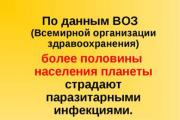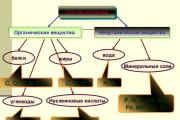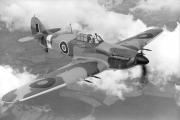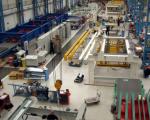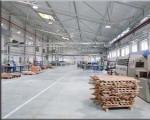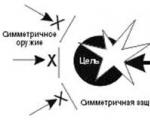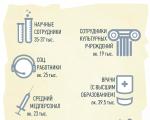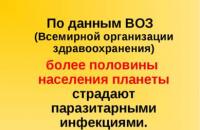28.01.2024
Metalworking machines. General information
Metal-cutting machines can be classified according to individual characteristics or a complex of characteristics. By technological purpose There are lathes, milling machines, drilling machines, etc. groups. According to the degree of versatility they distinguish: universal machines; wide application; specialized and special. Universal machines are designed to perform a variety of jobs using various workpieces. General-purpose machines are designed to perform specific work using workpieces of certain types. Specialized machines are designed for processing workpieces of one type, but different sizes(for example, processing a ring gear on a gear hobbing machine). Special machines perform completely certain type work on one specific workpiece. According to the degree of automation, there are manually controlled machines, semi-automatic machines, automatic machines, and program-controlled machines.
An automatic machine is a machine that does not require human intervention to resume the processing cycle. If to resume the processing cycle you only need to press the “start” button, then formally this is a semi-automatic machine. Based on the number of main working bodies, a distinction is made between single- and multi-spindle machines, single- and multi-position machines, etc. In terms of accuracy, there are five accuracy classes of machines: “N” - normal; “P” - increased; "B" - high; “A” - especially high accuracy; "C" - especially precise machines.
In Russian mechanical engineering it is accepted Unified system symbols machines, developed at ENIMS. In accordance with this system, each machine is assigned a specific code. The first two digits of the code determine the group and type of machine. The letter in second or third place allows you to distinguish between machines of the same standard size, but with different technical characteristics. The third or fourth digit shows the standard size of the machine. The last letter indicates various modifications of machines of the same basic model.
All metal-cutting machines are divided into 10 groups, and each group into 10 types. Below: The group number and name are in italics, and the number (0 to 9) and type name are in parentheses.
Group 0 - reserve.
Group 1 - lathes (0 - specialized automatic and semi-automatic; 1 - single-spindle automatic and semi-automatic;
2 - multi-spindle automatic and semi-automatic; 3 - revolver; 4 - drilling and cutting; 5 - carousel; 6 - turning and frontal; 7 - multi-cutters; 8 - specialized; 9 - different lathes).
Group 2- drilling and boring machines (0 - standby; 1 - vertical drilling; 2 - single-spindle semi-automatic;
- 3 - multi-spindle semi-automatic machines; 4 - coordinate boring;
- 5 - radial drilling; 6 - horizontal boring; 7 - diamond boring; 8 - horizontal drilling; 9 - different drilling tools).
Group 3- grinding and finishing machines (0 - reserve; 1 - cylindrical grinding; 2 - internal grinding; 3 - rough grinding; 4 - specialized grinding; 5 - reserve; 6 - sharpening; 7 - surface grinding; 8 - lapping and polishing; 9 - various, working with abrasive).
Group 4- combined machines.
Group 5 - gear and thread processing machines (0 - thread cutting; 1 - gear cutting for cylindrical wheels; 2 - gear cutting for bevel wheels; 3 - gear hobbing; 4 - for cutting worm pairs; 5 - for processing the ends of teeth; 6 - thread milling; 7 - gear finishing and calibration; 8 - gear and thread grinding; 9 - various gear and thread processing machines).
Group 6- milling machines (0 - backup; 1 - vertical console; 2 - continuous; 3 - backup; 4 - copying and engraving; 5 - vertical non-console;
6 - longitudinal; 7 - console wide-universal; 8 - horizontal console; 9 - different milling ones).
Group 7- planing, slotting, broaching machines (0 - reserve; 1 - single-column longitudinal planing; 2 - double-column longitudinal planing; 3 - transverse planing; 4 - slotting; 5 - horizontal broaching; 6 - reserve; 7 - vertical broaching; 8 - reserve; 9 - various planers).
Group 8- cutting machines (0 - reserve; 1 - cutting, working with a cutter; 2 - cutting, working with an abrasive wheel; 3 - cutting, working with a smooth disk; 4 - straightening-cutting; 5 - band saws; 6 - circular saws; 7 - saws hacksaws).
Group 9-
different machines (1 - filing; 2 - sawing; 3 - straightening and centerless-grinding; 4 - balancing; 5 - for testing drills and grinding wheels; 6 - dividing machines).
The standard size of a machine usually shows the largest size of the workpiece being processed. For example, a universal screw-cutting lathe mod. 16K20 - “20” - the height of the centers, i.e. distance from the axis of rotation of the workpiece to the guides, 200 mm; vertical drilling machine mod. 2N135 - “35” - largest drilling diameter - 35 mm.
CHAPTER 1. CLASSIFICATION OF METAL-CUTTING MACHINES AND MOVEMENTS IN THEM
§ 1. CLASSIFICATION AND SYMBOLS OF MACHINES
A metal-cutting machine is a machine designed to process a workpiece of a certain shape in accordance with the working drawing of the part by removing chips. Metal-cutting machines are classified according to various criteria.
According to the degree of specialization, machines are distinguished:
1) universal, used to perform various operations on a wide range of workpieces;
2) specialized, processing workpieces of the same type, similar in configuration, but having different sizes;
3) special, used for processing workpieces of the same standard size. Specialized and special machines are used in large-scale and mass production, and universal ones, as a rule, in single-piece and small-scale production.
By degree of accuracy(GOST 8-82 E) machines are divided into classes; normal accuracy (class N), increased (class P), high (class B), especially high precision (class A), as well as especially precision or master machines (class C). Class P machines are built with increased requirements for manufacturing and assembly accuracy. The accuracy of machines of classes B, A, C is achieved due to design features, high manufacturing precision and special conditions of assembly and operation in rooms with normal temperature and humidity.
Machines are divided by weight into light ones - weighing up to 1 ton, medium - up to 10 tons and heavy - over 10 tons. Heavy machines, in turn, are divided into large ones - from 10 to 30 tons, heavy ones - from 30 to 100 tons, especially heavy ones - weighing more than 100 t.
By type of work performed and cutting tools used All mass-produced machines are divided into nine groups, each group is divided into nine types of machines. The classification table (Table 1) was developed by ENIMS.
1. Classification of machines
| Machine tools |
Group |
Machine types |
| 1
|
2
|
3
|
4
|
5
|
6
|
7
|
8
|
9
|
Turning
|
1
|
Single-spindle automatic and semi-automatic machines |
Multi-spindle automatic and semi-automatic machines |
Revolving |
Drilling and cutting |
Carousel |
Turning and loboto-turning |
Multi-incisor |
Specialized for shaped products |
Various lathes |
Drilling and boring
|
2
|
Vertical drilling |
Single-spindle semi-automatic machines |
Multi-spindle semi-automatic machines |
Single-column jig boring machines |
Radial drilling |
Boring |
Diamond boring |
Horizontal drilling |
Various drilling |
Grinding, polishing, finishing
|
3
|
Cylindrical grinding |
Intra-grinding |
Roughing and grinding |
Specialized grinding machines |
-
|
Sharpening |
Surface grinders with rectangular or round table |
Lapping and polishing |
Various machines using abrasive tools |
Combined
|
4
|
Universal |
Semi-automatic |
Slot machines |
-
|
-
|
-
|
-
|
|
-
|
Continuation of the table. 1.
| Machine tools |
Group |
Machine types |
| 1
|
2
|
3
|
4
|
5
|
6
|
7
|
8
|
9
|
| Gear-thread-machining |
5
|
Gear planers for cylindrical wheels |
Gear cutters for bevel wheels |
Gear hobbing machines for cylindrical wheels and splined rollers |
Gear hobbing machines for worm wheels |
For machining the ends of wheel teeth |
Thread milling |
Tooth finishing |
Gear and thread grinding machines |
Various gear and thread machining |
| Milling |
6
|
Vertical milling console |
Continuous milling machines |
-
|
Copying and engraving |
Vertical non-console |
Longitudinal |
Widely versatile |
Horizontal console |
Various milling |
| Planing, slotting, broaching |
7
|
Longitudinal single-post |
Longitudinal two-post |
Cross-planing |
Slotting |
Long horizontal |
-
|
Long vertical |
-
|
Various planing |
| Split |
8
|
Cut-off machines working with a turning tool |
Cutting machines using an abrasive wheel |
Cut-off machines operating with a friction block |
Correctly-cutting |
tape |
Circular saws |
hacksaws |
-
|
-
|
| Different |
9
|
Coupling and pipe processing |
Sawmills |
Straight- and centerless-grinding |
-
|
For tool testing |
Dividing machines |
Balancing |
-
|
-
|
The model designation of commercially produced machines consists of a combination of three or four numbers, sometimes with the addition of letters. The first digit indicates the group number according to the classification table, the second digit indicates the type of machine. The third and sometimes fourth digits characterize the main parameters of the machine, which are different for machines different groups. So, for milling machines - this is the standard size of the table, for cross-planing and slotting machines - the maximum stroke of the slide, etc. The letter, if it is located between the numbers, indicates the modernization of the basic model of the machine. The letter after the numbers indicates the modification or accuracy class of the machine.
For example, a vertical drilling machine model 2N150: here 2 is drilling, H is modernization, 1 is vertical, 50 is the largest nominal drilling diameter.
In models of machine tools with program control, the letter F with a number is added to indicate the degree of automation: F1 - machines with digital display and preset of coordinates, F2 - machines with positional and rectangular numerical control (CNC) systems; F3 - machines with CNC contouring systems and F4 - machines with a universal CNC system for positional and contour processing. For example, the 6R11F3 machine is a vertical milling console with a contour CNC system with the first standard table size. For machines with cyclic program control systems, the index C has been introduced, with operational systems - the index T (for example, 16K20T1).
Modern metal-cutting machines use mechanical, electrical, electronic, pneumatic, and hydraulic systems to carry out the required movements and control the technological cycle.
According to their technological purpose, machines of turning, milling, drilling and other groups are distinguished. Universal machines are designed to perform a variety of jobs using different workpieces. Specialized machines are designed for processing workpieces of the same name, but of different sizes (for example, processing a ring gear on a gear hobbing machine). Special machines perform a very specific type of work on one specific workpiece. Machines are classified according to the degree of automation:
manually controlled, semi-automatic, automatic, program-controlled machines. Based on the number of main working bodies, a distinction is made between single- and multi-spindle machines, single- and multi-position machines, etc. There are machines: N - normal; P - increased; B - high; A - especially high; C - especially precise accuracy classes.
In the domestic mechanical engineering, a Unified system of symbols (ciphers) of machine tools, developed in ENIMS, has been adopted: the first two digits of which are the group and type of machine; the letter in second or third place is the standard size of the machine (and therefore its technical specifications); the third or fourth digit is the standard size of the machine; the last letter is a modification of machines of one basic model. All metal-cutting machines are divided into 10 groups, and each group into 10 types.
Machine tools can be divided into several types depending on the area of application, general technological features and design features. By area of application, machine tools are divided into:
Machine tools for the metallurgical industry and mechanical engineering;
Machines for chemical industry;
Shipbuilding equipment;
Equipment for aircraft construction;
Industrial machines;
Equipment for metalworking, woodworking.
Separately, there are machine tools used in microelectronics and machine tools for instrument making.
Metalworking machine equipment is a technique used for processing metal, producing parts of a given configuration and grinding surfaces of various profiles. It is classified depending on the type of metalworking.
Lathes – equipment designed for turning external, internal, end surfaces of rotating and cutting bodies various types threads It is divided into several types: rotary lathes, screw-cutting lathes, turret lathes, CNC lathes, table-top lathes.
Milling machines are used to process flat and shaped surfaces and rotating bodies using a cutter. There are: vertical milling, universal milling, tabletop milling, wide-universal milling machines. As subtypes there are vertical drilling and milling, horizontal milling, drilling and milling, universal drilling and milling equipment, CNC machines and processing milling centers.
Grinding machines are equipment designed for finishing parts by removing the top layers from their surface with a high degree of precision. The machines can be cylindrical, internal, flat or centerless grinding.
Drilling machines are used for drilling blind and through holes in solid material. The technique allows you to drill, countersink, ream and cut internal threads. There are horizontal, vertical and radial drilling types.
Band saws are designed for cutting wooden or metal products. Types: portal, two-column, console, horizontal, desktop and household machines.
Boring machines involve the processing of large parts by drilling, cutting, trimming, turning, etc.
The sharpening machine is used for sharpening and regrinding metal-cutting tools.
Balancing machines are designed to measure and determine the location of static or dynamic imbalance of rotating parts.
Slotting machines are necessary for processing flat and shaped surfaces, keyways, and grooves.
Rolling machines are equipment that processes sheets by bending to give the product a cylindrical shape.
Machining centers allow parts to be subjected to complex processing.
General information about metal-cutting machines
Topic 1. Classification of metalworking machines
Metal cutting machine
- This technological machine, intended for processing materials by cutting in order to obtain parts of a given shape and size (with the required accuracy and quality of the machined surface). The machines process workpieces not only from metal, but also from other materials, so the term “metal-cutting machine” is conditional. Machines are classified according to various criteria, the main ones of which are given below.
According to the type of work performed, metal-cutting machines (in accordance with the ENIMS classification) are divided into nine groups, each of which is divided into nine types, united by common technological characteristics and design features (Table 3.1).
Marking. Models of mass-produced machines are assigned a digital or alphanumeric designation. As a rule, the designation consists of three to four numbers and one or two letters.
The first digit is the number of the group to which the machine belongs, the second is the number of the machine type, the third and fourth characterize one of the main parameters of the machine or the part processed on it (for example, the height of the centers, the diameter of the rod, the dimensions of the table, etc.). The letter after the first or second digit indicates that the machine has been modernized, the letter after the digits indicates a modification (modification) of the basic model of the machine. For example, model 7A36 means: 7 - planing-broaching group, 3 - cross-planing, 6 - maximum length of the workpiece 600 mm, the letter A indicates the modernization of the machine of the base model 736.
If the letter appears at the end of the model designation, then it indicates the accuracy class of the machine, for example 16K20P is a machine with a high accuracy class; normal accuracy class is not indicated in the model name
In CNC machine models, the last two characters are the letter F s
number (1 - machine with digital display and preliminary set of coordinates; 2 - with a positional control system; 3rd contour control system; 4 - with a combined control system for positional and contour processing). For example, a semi-automatic gear hobbing machine with a combined CNC system - model 53A20F4, a vertical milling machine with a cross table and a digital display device - model
6560F1.
At the end of the model designation of machines with cyclic control systems the letter C is placed, and with an operational control system - the letter T. For example: multi-cutter-copying semi-automatic lathe with cyclic program control - model 1713C; lathe with an operational control system - model K20T1.
The presence of a tool magazine in the machine is indicated in the model by the letter M; for example, a drilling machine with a position control system for a high-precision tool magazine - model 2350ПМФ2.
Bydegree of versatility
machines are divided into:
Universal,
Specialized
Special.
Pabout the degree of processing accuracy
machines are divided into five classes.
- N– Normal accuracy; Most universal machines belong to this class;
- P– increased accuracy; machines of this class are manufactured on the basis of machines of normal accuracy, but the requirements for the accuracy of processing of machine parts, the quality of assembly and regulation are much higher;
- IN– high precision, achieved through the use of specially designed individual components, high requirements for the precision of manufacturing parts, quality of assembly and control of the machine as a whole;
- A– particularly high precision; these machines are subject to even more stringent requirements than class B machines;
- WITH- especially precise, or master machines, they produce parts for machines of classes B and A.
Depending on weight
machines are divided into:
Lungs -
weighing up to 1 t,
Average -
up to 10 t
Heavy -
over 10 tons. In turn, heavy machines are divided into large (up to 30 tons), actually heavy (up to 100 tons) and unique (over 100 tons).
Bydegree of automation
distinguish:
Manually operated machines,
Semi-automatic
Automatic machines.
Byspindle location
machines are divided into:
Horizontal,
Vertical
Inclined.
Bydegree of concentration
machine operations are divided into:
Single position;
Multi-position. .
Table 1. Classification of metalworking
Movements in machines
When manufacturing parts on machines, a tool or workpiece can perform the following movements: main, feed, division, rolling, differential and auxiliary.
Main cutting movement D
r
ensures removal of chips from the workpiece at the highest speed during the cutting process. The main movement can be rotational and linear translational (Figure 3.1). This movement can be performed by both the workpiece and the cutting tool. 
Figure 1. Movements in machines
Feed movement D
s
allows you to bring new areas of the workpiece under the cutting edge of the tool, thereby ensuring the removal of chips from the entire machined surface.
Feed speed v s
when cutting with blades, it is set in mm/min.
Division movements
are implemented to implement the required angular (or linear) movement of the workpiece relative to the tool. The dividing movement can be continuous (in gear shaping, gear hobbing, gear planing, backing and other machines) and intermittent (for example, in dividing machines when cutting strokes on a ruler). Intermittent movement is achieved using a ratchet wheel, Maltese cross or dividing head.
Rolling movement
- this is the coordinated movement of the cutting tool and the workpiece, reproducing the engagement of a certain kinematic pair during shaping. For example, during gear shaping, the cutter and the workpiece reproduce the meshing of two gears. The rolling movement is necessary for shaping in gear-processing machines: gear hobbing, gear planing, gear shaping, gear grinding (when processing cylindrical and bevel wheels).
Differential movement
added to any movement of the workpiece or tool. To do this, summing mechanisms are introduced into the kinematic chain. It should be noted that only homogeneous movements can be summed up: rotational with rotational, translational with translational. Differential movements are necessary in gear hobbing, gear planing, gear grinding, backing and other machines.
The considered movements are involved in the shaping of the workpiece. However, it is also necessary to carry out other movements on the machine: bring the cutting tool to the workpiece, retract it after finishing processing, clamp the workpiece, remove it, install a new one, switch the speed or feed, turn off the machine. Such movements are called auxiliary they prepare the cutting process, but do not participate in it themselves.
Auxiliary movements are carried out manually or in an automatic cycle. Automation of auxiliary movements increases labor productivity.
Security questions
1. By what criteria are metal-cutting machines classified?
2. How is the model code for serial production machines formed? Give examples.
3. What accuracy classes of machine tools do you know?
4. What is called the main movement? Give examples of machines in which the main movement is rectilinear.
5. What movements are the main ones?
6. How can you distinguish a manually controlled machine from a programmatically controlled machine based on the model designation?
7. Name the auxiliary movements that can be performed on a lathe.
Topic 2. Basic machine parts
Load-bearing or base parts of machine tools are designed to create the required spatial arrangement of units carrying a tool or workpiece, and ensure the accuracy of their relative position under load. The set of basic parts between the tool and the workpiece forms the supporting system of the machine.
Basic parts must have:
High initial manufacturing accuracy of all critical surfaces to ensure the required geometric accuracy of the machine;
High damping properties, that is, the ability to dampen vibrations between the tool and the workpiece from various sources of vibration;
High rigidity determined by specific deformations of moving and fixed joints, local deformations and deformations of the base parts themselves;
Durability, which is expressed in the stability of the shape of the base parts and the ability of the guides to maintain their original accuracy for a given period of operation.
In addition, the base parts must have small thermal deformations, due to which relative displacements of the workpiece and tools can occur.
Beds and bed guides
Bed.
The bed is used for mounting parts and assemblies of the machine; moving parts and assemblies are oriented and moved relative to it.
The bed, like other elements of the supporting system, must ensure during the service life of the machine the ability to process workpieces with specified modes and accuracy. This is achieved the right choice design, material of the frame and its manufacturing technology to ensure the necessary rigidity, vibration resistance and wear resistance of the guides.
Beds are divided into horizontal and vertical (racks).
The main material for manufacturing is cast iron - for cast frames, steel - for welded ones

Figure 2 - Sections of horizontal (a) and vertical (5) frames
Guides.
The required relative position of machine components and the possibility of relative movement of the tool and workpiece are provided by guides.
According to their purpose and design, guides can be classified according to the following criteria:
By type of movement: guides of the main movement (for example, a table-bed of a longitudinal planing machine); feed movement guides; directing rearrangements of associated and auxiliary parts and assemblies that are stationary during processing;
Along the trajectory of movement: guides of rectilinear and circular movement;
In the direction of the trajectory of movement of the node in space: horizontal, vertical and inclined;
By geometric shape: prismatic, flat, cylindrical, conical (only for circular motion) and their combinations.

Figure 3 - Adjustment elements with longitudinal (A) and transverse (b) wedge, with pressure (V) and customized delivery note (G) bar
The most widespread in machine tools are sliding and rolling guides.Sliding guides
(Figure 4) are usually made from gray cast iron. Cast iron is used in cases where the guides are made as one piece with the frame or moving unit.

Figure 4 - Basic forms cross sections sliding guides:
A- flat; b- prismatic; V- dovetail shaped; G- cylindrical
Based on the type of sliding friction, the following guides are distinguished:
Hydrostatic (Figure 5) - guides of the main movement and feed; in these guides the lubricating layer is created by supplying oil under high pressure into special pockets required sizes;
With mixed lubrication - most feed guides;
With boundary lubrication - feed guides operating at very low sliding speeds;
With air lubrication - aerostatic.
Oil supply to pockets

Figure.5 - Diagram of hydrostatic guides
Widely used in machine toolsrolling guides
using balls and rollers as intermediate rolling bodies. The advantage of rolling guides is low friction, independent of the speed of movement. Rolling guides provide high accuracy of movements, uniformity of slow movements, they are more durable than sliding guides. Like sliding guides, rolling guides can be closed or open.
Guide rail protection devices
ensure their reliable operation and protect working surfaces from dust, chips and dirt. Shields attached to the moving unit of the machine (Figure 6,A)
or, less often, to the frame, used for small movements of the moving unit. Telescopic shields, consisting of several movable steel shields (Figure 6,b)
with seals in moving joints, used in medium and heavy machines with significant stroke lengths. Steel belts(Figure 6.c - d)
used on various machines with a long stroke of the moving unit. Harmonica-shaped bellows (“accordions”) (Figure 6, e), made from various ny materials, including polymers, provide high tightness, are used on grinding and other machines.
Figure 6 - Protective devices for guides:
A- shields; b- telescopic shields; V,g, d - ribbons; e- harmonica-shaped bellows
Spindle and its supports
Spindle
- this is the shaft of a metal-cutting machine that transmits rotation to the tool or workpiece fixed in it.
The structural shape of the spindle depends on the method of fastening the clamping fixture or tool on it, the fit of the drive elements and the types of supports used. Spindles are made hollow for the passage of the rod, as well as to reduce its weight.
Rolling and sliding bearings are used as supports for machine tool spindles. Since high precision is required from spindles, rolling bearings must be of high accuracy classes. The front support uses more precise bearings than the rear one. Spindles and bearings must be reliably protected from contamination and cutting out of lubricant; for this purpose, various seals are used.
Security questions
1. What is this bed?
2. Classification of guides.
3. Define a spindle.
Topic 3. Gears used in machine tools
Transmission of rotational motion.
To change the rotation speed from the driving link to the driven one, belt, gear and worm drives are used. Driver speed ration
vd
to the driving speedn
vsch
the link is calledgear ratio.
Belting
used to transmit rotational motion between shafts distant from each other. (Figure 3.7, a)

Figure 7 - Rotational motion transmissions
Chain transmission
,
like a belt, it is used to transmit rotation between shafts remote from each other. These gears are used in metal-cutting machines and conveyors. (Figure 7, b)
Gear
- a mechanism that, using gearing, transmits and converts motion (without slipping) with changes in angular velocities and moments. (Figure 7, c)
Worm gear
consists of a worm and a worm wheel. The gear ratios of the worm gear are calculated using the formulai
=
z
h
/z
h.k.
,
Where z
h
– number of worm passes;z
h.k.
- number of teeth of the worm wheel. (Figure 7, d)
The advantages of a worm gear are compactness, noiselessness, smooth running, and the possibility of large reduction; the disadvantages of gears include low efficiency.
Translation of translational motion.
These gears serve to convert rotational motion into rectilinear translational motion of the working body. Machine tools use rack and pinion gears, screw pairs (sliding and rolling), rocker, cam mechanisms, etc.
Rack and pinion transmission
serves to convert the rotational movement of the rack and pinion wheel
into translational movement of the rack and vice versa. The rack and pinion transmission can be made with spur and helical gearing of the wheel and the rack.
Rack and pinion gears are used in metal-cutting machines, for example, in lathes, to carry out the movement of the longitudinal feed of the support with the cutter relative to the workpiece being processed.
Screw transferred
used in cases where it is necessary to obtain movement at low speeds. Rotation is imparted to the screw; the nut and the table or slide associated with it move linearly and progressively.
Crank-yoke mechanisms (abbreviated as rocker mechanisms) with a returning rocker are used in slotting machines, and with a touching rocker - in cross-planing machines. Rocker mechanisms provide greater speed during reverse idle and smooth movement.
Mechanisms of periodic movements.
Some machines require periodic changes in the position of its elements or individual components. For this purpose, ratchet and Maltese mechanisms, partial gears, cam mechanisms and mechanisms with overrunning clutches, electric, pneumatic and hydraulic mechanisms are used.
Ratchets
most often used in the feed mechanisms of machine tools in which the movement of the workpiece, cutting (cutter, grinding wheel) or auxiliary (diamond for dressing the grinding wheel) tool is carried out during overrun or return stroke (in planing, slotting, grinding machines, dividing machines).
In most cases, ratchet mechanisms are used for linear movement of machine components. The pawl periodically turns a ratchet wheel with external and internal teeth at a certain angle, which is kinematically connected to the lead screw for moving the table, support, etc. Ratchet mechanisms are also used to
circular periodic movements.
Maltese mechanisms
used primarily in dividing devices with a constant angle of periodic rotation, for example, for turning turrets, spindle blocks and tables of automatic lathes, multi-position tables, etc.

Figure 8 - Ratchet mechanisms with asymmetrical (a), symmetrical (b) tooth profile and flat Maltese gear (c):
1 – ratchet wheel, 2 – pawl, 3 – lever, 4 – crank mechanism, 5 – crank disk, 6 – pin, 7 – screw, 8 – pin, 9 – shield, 10 – Maltese cross, 11 – roller, 12 – crank, α – angle that determines the position of the Maltese cross grooves, ß – angle between the axes of the crank and the Maltese cross.
Security questions
1. What gears in machine tools convert rotational to translational motion of a unit?
2. Name the mechanisms of periodic movements. What machines are they used in?
Topic 4. Gearboxes
Speed boxes are structurally included in the step control drive of the main movement of the machine.
Gearboxes provide:
Large range D output speed control: D = n max /n min .
Here n max
And n min
respectively, the maximum and minimum rotation speed (min 1) of the spindle, with a linear main movement - the maximum and minimum number of double strokes per minute of the slide or table;
No slippage (constant gear ratio);
Constant power transmission;
A fairly large number of different output speeds with relatively small sizes of the gearboxes themselves;
Transmission of high torques;
High efficiency.
The gearboxes are compact, easy to maintain and reliable in operation.

Figure 9 - Twin-shaft gearboxes with a movable gear unit (a) and a clutch (b):
I – drive shaft, II – driven shaft, 1 – coupling
According to the method of switching gears, gearboxes are:
-
with replaceable gears
, which are most often used in specialized machines, automatic and semi-automatic machines with relatively rare settings of the main movement drive. They have small overall dimensions and eliminate the possibility of emergency gear shifting. At the same time, the time for changing wheels increases when it is necessary to change the speed;
- with movable blocks of gear wheels and couplings
, which are widely used mainly in universal manually operated machines. CNC machines use gears that are switched automatically using individual electromechanical (less often hydraulic) drives.
According to the layout, gearboxes with undivided and separated drives are distinguished. In the first case, the gearbox is located in the spindle head, and in the second, it is located outside of it.
Topic 5. Clutches and braking devices
Couplings.
To connect two coaxial shafts in machine tools, couplings of various types are used.
Non-disengaging couplings
serve for rigid connection of shafts. For example, connections using a sleeve,
through elastic elements or through an intermediate element having two mutually perpendicular protrusions on the end planes
and allowing to compensate for the misalignment of the connected shafts.
Interlocking couplings
used for periodic connection of shafts. The machines use interlockingcam
couplings in the form of disks with end teeth-cams
And gear
couplings. The disadvantage of meshed couplings is the difficulty of engagement when there is a large difference in the angular velocities of the driving and driven elements.
Friction clutches
devoid of the indicated disadvantage of meshed couplings, they can be engaged at any speed of rotation of the driving and driven elements. The possibility of slipping of the driven element under overload prevents accidents of the machine mechanisms. Friction clutches come in cone and disk types. In main motion and feed drives, multi-disc clutches are widely used, transmitting significant torques with relatively small dimensions.

Figure 10 - Couplings for connecting shafts:
a – rigid bushing type; b – with elastic elements; c – cross-sliding; g – cam; d – multi-disc with mechanical drive; e – electromagnetic; 1 – washer: 2 – disk; 3- ball; 4,5,8,12 – bushings; 6 – nut; - 7 – spring: 9 – coil; 10 – disks; 11 – anchor
Safety couplings
,
connecting two shafts under normal operating conditions, break the kinematic chain when the load is exceeded. This occurs when a special element is destroyed, when mating or rubbing parts (for example, disks) slip and the cams of the two mating parts of the coupling disengage. The element to be destroyed is usually a pin, the cross-sectional area of which is calculated in accordance with a given torque.
Overrunning clutches
are designed to transmit torque when the links of a kinematic chain rotate in a given direction and to separate them when rotating in the opposite direction, as well as to transmit to a shaft different rotation frequencies, for example, slow (working) and fast (auxiliary). The overrunning clutch allows you to transmit additional (fast) rotation without turning off the main chain.
Braking devices.
Braking devices are used to stop or slow down the movement of moving units or individual elements of machine tools.
. Braking can be carried out by mechanical, electrical, hydraulic, pneumatic or combination means. In machines that do not have a hydraulic or pneumatic drive, mechanical or electrical braking is used. Main types of mechanical brakes: band,
block
and multi-disc.
A multi-disc brake is a conventional multi-disc clutch, the housing of which is rigidly fixed to a stationary part of the machine. The brake drive on universal machines is usually manual. On automated machines, the brake drive is controlled remotely by program.
The brakes are installed on the high-speed shafts of the gearboxes. If necessary, they are blocked with starting clutches.
Security questions:
1. What are gearboxes used for?
2. Are there different types of gearboxes based on the method of shifting gears?
3.Describe the classification of couplings.
4. Purpose of braking devices.
5. Main types of mechanical brakes?
Topic 6. Gearboxes
Gearboxes
in metal-cutting machines they are designed to change the magnitude and direction of feed by switching gears.
Cone set with ring gear
used in feed drives of manually controlled screw-cutting lathes. The number of gears in this set reaches ten, switching is done using a handle1
, moving the cap wheel2.
The advantage of this transmission is its low metal consumption (the number of gears is two more than the number of gears). However, due to the presence of a ring gear, the cone set cannot be used in machines that transmit high power, since the mechanism has low rigidity. Another disadvantage is the impossibility of using this transmission in chains where the movement of the drive shaft is reversed, since the movement from the cone to the ring gear (or vice versa) can only be transmitted in the direction indicated in the figure.
Taper set with draw key
- a compact mechanism that implements up to 10 different gear ratios. Shifting of all gears of a pair of cones is controlled by one handle connected to a draw key3.
The disadvantages of this mechanism include: the inability to transmit large torques due to insufficient rigidity of the hollow shaft in which the rod with the draw key moves; unsatisfactory alignment of narrow gears; increased wear of gears (all are constantly in mesh) and draw key; low efficiency.

Figure 11 - Feedbox mechanism diagrams:
a - cone set with ring gear; 6 - conical set with draw key; c - bevel differential: d - planetary mechanism; d - single-pair guitar; 1 - handle; 2 - ring gear; 3 - draw key; 4 - T-shaped shaft; 5- dragged 6 - guitar cover; 7. 8-replaceable gears
Guitar
- this is a link in adjusting the kinematic chain using replaceable gears; used in various kinematic chains: gearboxes, feeds, running in differential circuits of various types of machine tools, especially in serial and mass production. In most cases, to obtain specified gear ratios, either a double-pair guitar (two pairs of replaceable gears) or a single-pair guitar is used (Figure 3.11,d);
Three-pair guitars are used extremely rarely when small gear ratios are needed or high precision tuning is required. Single-pair guitars do not provide high accuracy in selecting a given gear ratio, since usually there are very few replacement wheels in the set (8... 10 pieces) and, in addition, the design of the guitar is such that the distance between the axles of the replacement wheelsB =
const. When selecting two replacement gearsz
1
And z
2
it is necessary to satisfy the condition of their adhesion
IN= m(z, + z 2
)/2,
(1)
Where T - gear module.
Continuously Variable Transmissions
do not provide precise gear ratios, so they are used only in cases where feeds are determined by cutting conditions.












